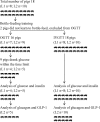Establishment of a Refined Oral Glucose Tolerance Test in Pigs, and Assessment of Insulin, Glucagon and Glucagon-Like Peptide-1 Responses
- PMID: 26859145
- PMCID: PMC4747562
- DOI: 10.1371/journal.pone.0148896
Establishment of a Refined Oral Glucose Tolerance Test in Pigs, and Assessment of Insulin, Glucagon and Glucagon-Like Peptide-1 Responses
Abstract
Diabetes mellitus is increasing worldwide and reliable animal models are important for progression of the research field. The pig is a commonly used large animal model in diabetes research and the present study aimed to refine a model for oral glucose tolerance test (OGTT) in young growing pigs, as well as describing intravenous glucose tolerance test (IVGTT) in the same age group. The refined porcine OGTT will reflect that used in children and adolescents. Eighteen pigs were obtained one week after weaning and trained for two weeks to bottle-feed glucose solution, mimicking the human OGTT. The pigs subsequently underwent OGTT (1.75 g/kg BW) and IVGTT (0.5 g/kg BW). Blood samples were collected from indwelling vein catheters for measurements of glucose and the diabetes related hormones insulin, glucagon and active glucagon-like peptide-1. The study confirmed that pigs can be trained to bottle-feed glucose dissolved in water and thereby undergo an OGTT more similar to the human standard OGTT than previously described methods in pigs. With the refined method for OGTT, oral intake only consists of glucose and water, which is an advantage over previously described methods in pigs where glucose is given together with feed which will affect glucose absorption. Patterns of hormonal secretion in response to oral and intravenous glucose were similar to those in humans; however, the pigs were more glucose tolerant with lower insulin levels than humans. In translational medicine, this refined OGTT and IVGTT methods provide important tools in diabetes research when pigs are used as models for children and adolescents in diabetes research.
Conflict of interest statement
Figures






Similar articles
-
On the role of the gut in diabetic hyperglucagonaemia.Dan Med J. 2017 Apr;64(4):B5340. Dan Med J. 2017. PMID: 28385175 Review.
-
Male grower pigs fed cereal soluble dietary fibres display biphasic glucose response and delayed glycaemic response after an oral glucose tolerance test.PLoS One. 2018 Mar 1;13(3):e0193137. doi: 10.1371/journal.pone.0193137. eCollection 2018. PLoS One. 2018. PMID: 29494594 Free PMC article.
-
Altered Plasma Levels of Glucagon, GLP-1 and Glicentin During OGTT in Adolescents With Obesity and Type 2 Diabetes.J Clin Endocrinol Metab. 2016 Mar;101(3):1181-9. doi: 10.1210/jc.2015-3885. Epub 2016 Jan 8. J Clin Endocrinol Metab. 2016. PMID: 26745255
-
Insulin sensitivity and secretion changes after gastric bypass in normotolerant and diabetic obese subjects.Ann Surg. 2013 Mar;257(3):462-8. doi: 10.1097/SLA.0b013e318269cf5c. Ann Surg. 2013. PMID: 23388352
-
Glucose-dependent insulinotropic polypeptide: effects on insulin and glucagon secretion in humans.Dan Med J. 2016 Apr;63(4):B5230. Dan Med J. 2016. PMID: 27034187 Review.
Cited by
-
Intraperitoneal and subcutaneous glucagon delivery in anaesthetized pigs: effects on circulating glucagon and glucose levels.Sci Rep. 2020 Aug 13;10(1):13735. doi: 10.1038/s41598-020-70813-5. Sci Rep. 2020. PMID: 32792580 Free PMC article.
-
Effects of gruel feeding and oral dextrose on the survivability of pigs after weaning.Transl Anim Sci. 2023 Jul 19;7(1):txad082. doi: 10.1093/tas/txad082. eCollection 2023. Transl Anim Sci. 2023. PMID: 37649645 Free PMC article.
-
Exploring the GLP-1-GLP-1R axis in porcine pancreas and gastrointestinal tract in vivo by ex vivo autoradiography.BMJ Open Diabetes Res Care. 2021 Apr;9(1):e002083. doi: 10.1136/bmjdrc-2020-002083. BMJ Open Diabetes Res Care. 2021. PMID: 33903116 Free PMC article.
-
Effects of Tributyrin Supplementation on Growth Performance, Insulin, Blood Metabolites and Gut Microbiota in Weaned Piglets.Animals (Basel). 2020 Apr 22;10(4):726. doi: 10.3390/ani10040726. Animals (Basel). 2020. PMID: 32331306 Free PMC article.
-
Full closed loop open-source algorithm performance comparison in pigs with diabetes.Clin Transl Med. 2021 Apr;11(4):e387. doi: 10.1002/ctm2.387. Clin Transl Med. 2021. PMID: 33931977 Free PMC article.
References
-
- WHO. Diabetes Fact Sheet N312: World Health Organization; 2015 [2015-12-09]. Available: http://www.who.int/mediacentre/factsheets/fs312/en/.
-
- Franco OH, Steyerberg EW, Hu FB, Mackenbach J, Nusselder W. Associations of diabetes mellitus with total life expectancy and life expectancy with and without cardiovascular disease. Arch Intern Med. 2007;167(11):1145–51. - PubMed
Publication types
MeSH terms
Substances
Associated data
LinkOut - more resources
Full Text Sources
Other Literature Sources
Medical

